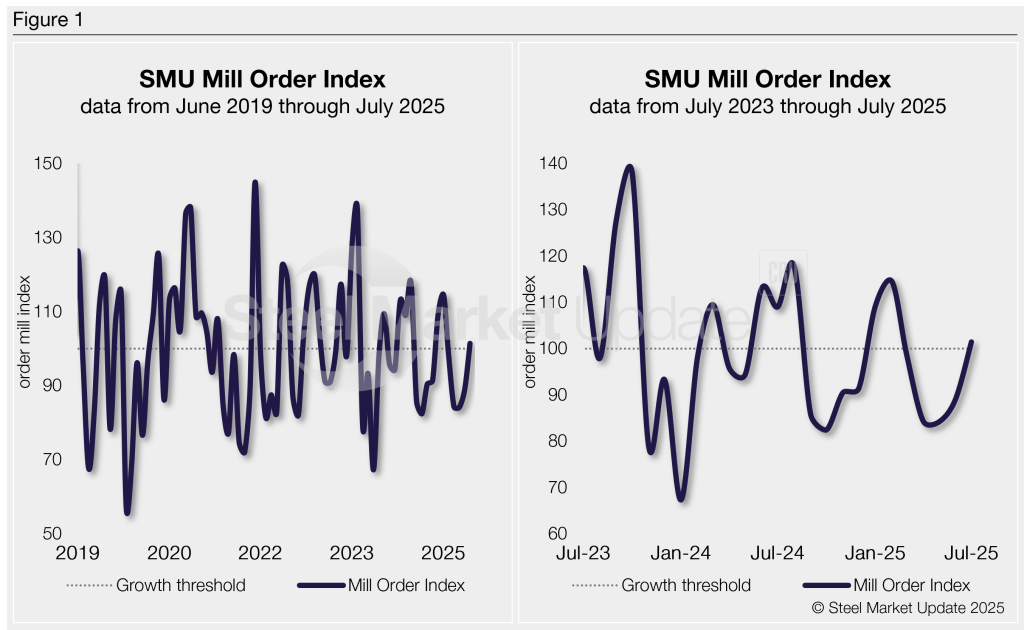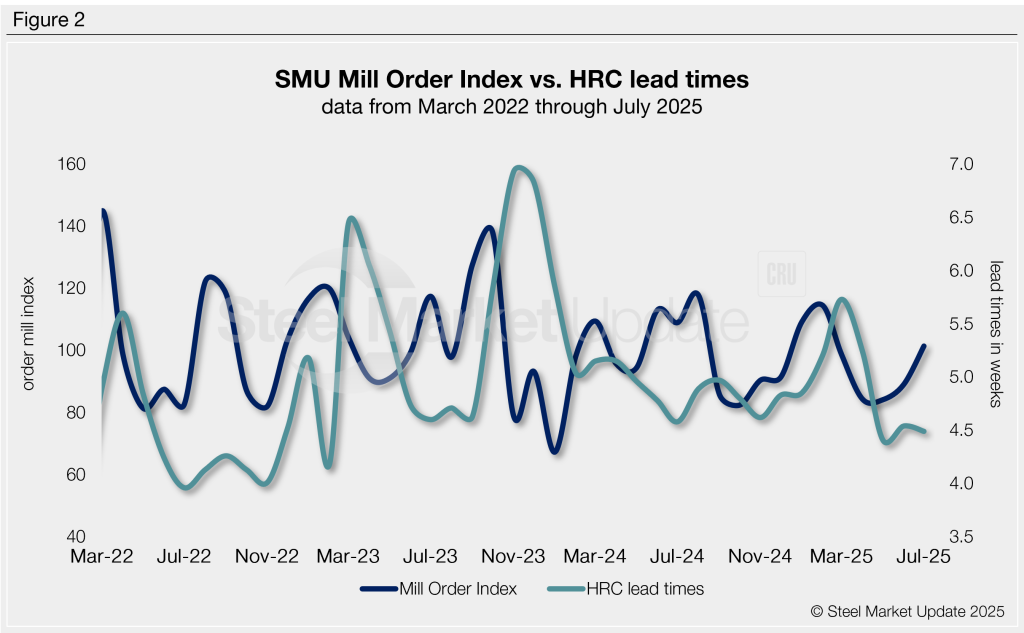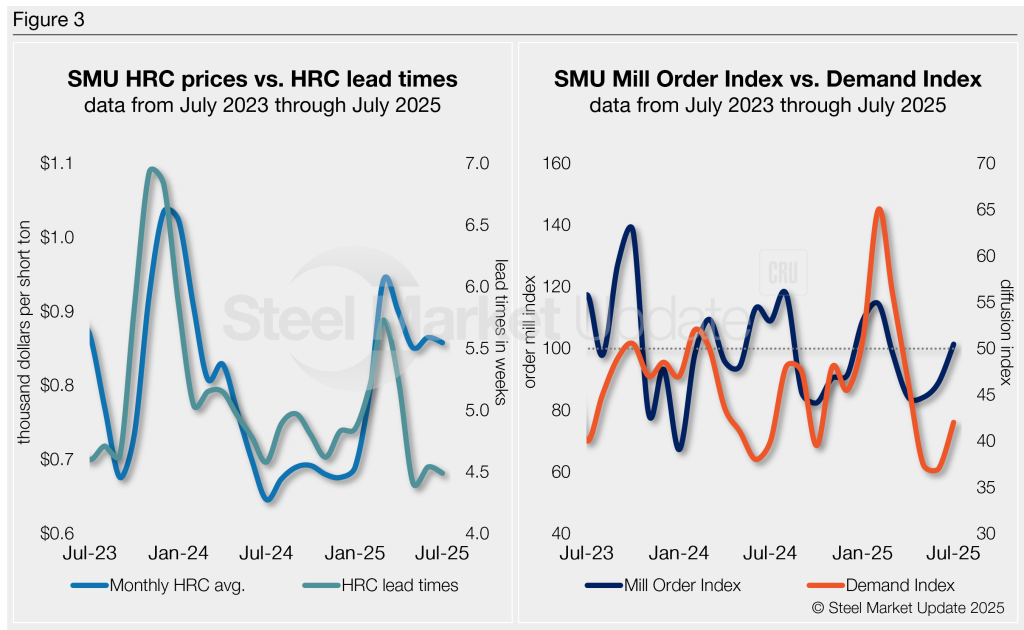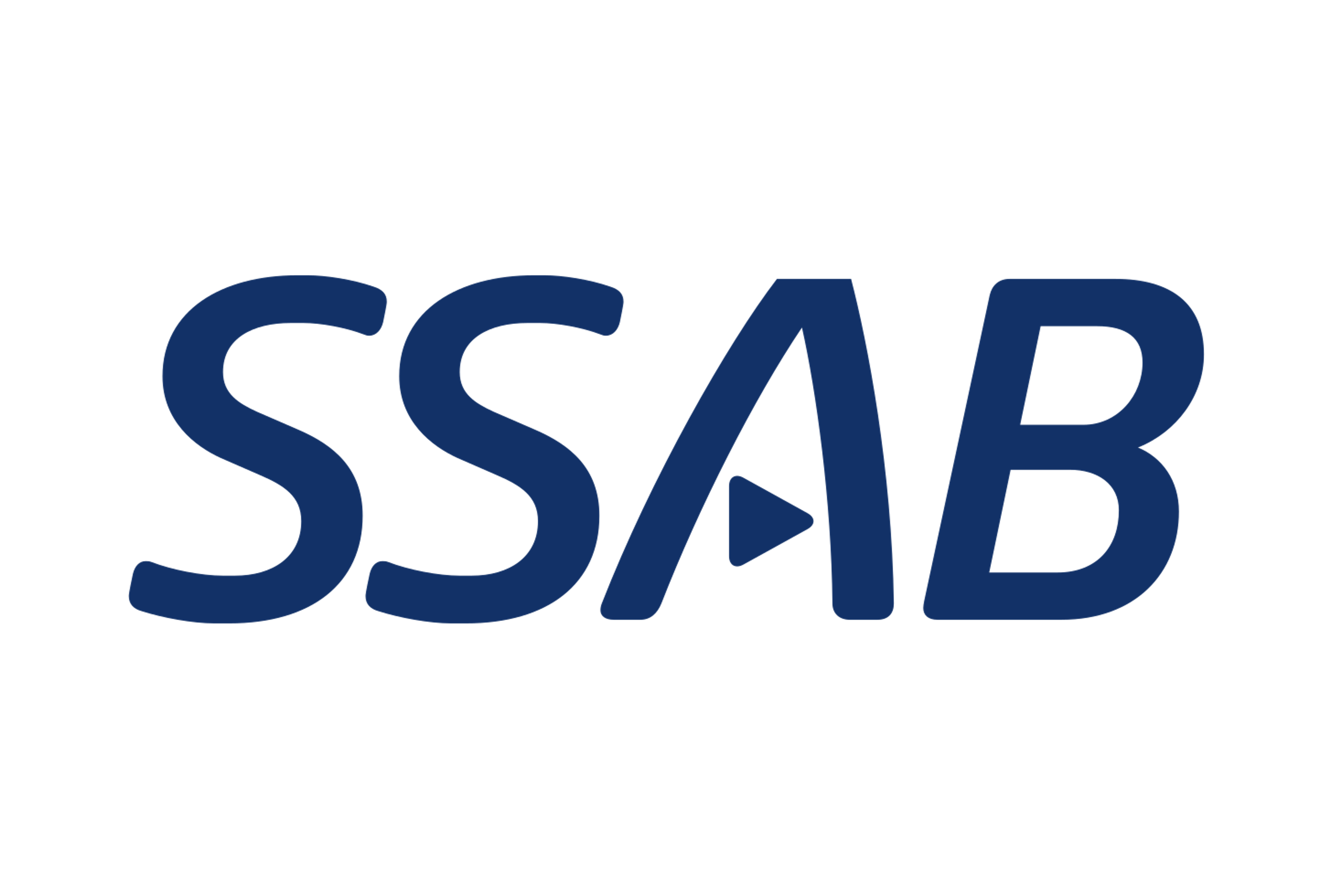Analysis

August 19, 2025
Service centers: Mill orders improve in July
Written by David Schollaert
SMU’s Mill Order Index (MOI) moved higher in July after rebounding the month prior. The shift comes after mill orders declined from March through May. The gain, however, came as service center shipping rates slowed slightly, according to our latest service center inventories data.
A similar uptick in intake and new order entries in July underscored the result. The repeated gain comes even as service centers continue to work on rightsizing inventories. There’s a likelihood that prices have been too attractive for buyers to destock.
Downstream buyers remain very cautious and buy mostly on an as-needed basis. This dynamic was highlighted as service centers’ daily shipping rate declined 3.8% from June to July.
The MOI now stands at 101.4, up 13.9% from 89 in June. The result still falls far short of February’s six-month high of 114.5. And it’s the first time the index moved above the 100 mark in five months.
Methodology
SMU derives its MOI—a relative index that evaluates the latest change in service center mill order entries—from our monthly service center inventories data. This index is a good indicator of current service center buying patterns, displaying perceived demand and lead times. This stands out because lead times typically signal upcoming moves in steel prices.
The MOI uses a base period, presently 2022-24, to establish a reference point for measuring service centers’ mill orders over time. This base period is assigned an index value of 100. Subsequent MOI values are then calculated relative to this base.
An index score above 100 indicates an increase in buying, and a score below 100 indicates a decrease.
Figure 1 shows the nearly six-year history of the index on the left and provides a closer look at the MOI readings of the past two years on the right (100 = 2022-24 average).

Background
After restocking in the second half of 2024, demand shifted and soured. The focus shifted sharply to inventory control.
Despite brief price spikes—driven by sudden price increases from mills— market conditions stayed soft due to sluggish end-use demand (as shown in the right-side chart in Figure 1 above).
In response, a rise in intake volume was reported for most of Q1. A boost in buying from downstream customers pulled forward demand ahead of tariff-fueled price increases. A rapid rise in mill prices was triggered by the increase in service center orders.
The skinny
Weak demand has been front and center since the tariff-driven buying surge fizzled out. With downstream buyers either stocked or only maxing out on contract orders, there’s been no spike in service center shipments, with a marginal decline from the early Q1 buys. SMU’s MOI could still edge up some, but most likely little variation in the near term, with service centers keeping inventories in check and no downstream push for product.
SMU’s MOI pairs well with—and has for the past five years proceeded—moves in mill lead times (Figure 2). And SMU’s lead times have also been a leading indicator of flat-rolled steel prices, particularly for HRC (see left-side chart in Figure 3).
Our MOI also pairs well with our Steel Demand Index (see right-side chart in Figure 3), which, for nearly a decade, has preceded moves in mill lead times.


Prices have been steadily declining after a short-lived bump in response to President Trump doubling Section 232 tariffs on imported steel to 50% on June 3.
The move initially stopped the price erosion, but only momentarily. Prices moved up roughly $45 per short ton (st) through June but have since declined almost week-in and week-out since. US hot band prices are currently $820/st, down $10/st week over week (w/w), according to our Aug. 12 check of the market.
And lead times were steady latest assessment on Aug. 6. They are presently 4.4 weeks on average, flat 4.4 weeks in late July.
But keep in mind, this is July service center data. While demand indications might still be pointing lower, there’s not much in the way of spot buying even as mills have been cutting deals. Even on small volume buys.
With moderate demand expectations and ongoing pricing uncertainty across markets, service centers appear focused on maintaining inventory levels. This is especially true as the market moves through a historically slower summer period.
Service center shipments will need to continue improving, which they haven’t in recent months. But if downstream inventories remain steady and buyers focus only on immediate needs, a significant shift in demand will be necessary to support stronger prices. Something some suggest we could see in conjunction with Fall maintenance outages.
We’ll be tracking any changes closely as we move closer to Q4.
Editor’s Note
Order entries, demand, lead times, and prices are based on the average data from manufacturers and steel service centers who participate in SMU’s monthly inventories and every other week market trends analysis surveys. Our demand and lead times do not predict prices but are leading indicators of overall market dynamics and potential pricing dynamics. Look to your mill rep for actual lead times and prices.







